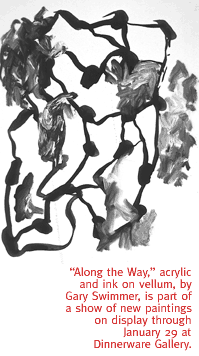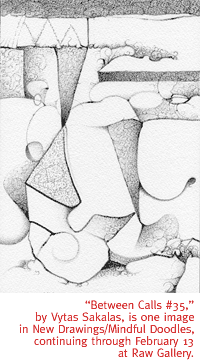

|

Local Exhibits Stretch Artistic Media Into New And Surprising Forms.
By Margaret Regan
GARY SWIMMER CAN make a realistic painting when he wants
to.
He even proves it with "Simple Landscape: Back to Basics."
Its sky may be red, its tree blue-brown, and its earth blue-green,
but this deft little watercolor is an island of realism in a sea
of abstraction in Swimmer's show at Dinnerware.
 With its tongue-in-cheek subtitle, "Simple Landscape"
shows that Swimmer could paint the public what it wants, if only
he cared to. The thing is, he mostly doesn't. That little stretch
of strangely colored land aside, his big exhibition of small paintings
has nothing to do with representations of the real world. New
Paintings: Abstractions on an Intimate Scale is all about
pattern, and texture, and materials. It's about black ink flowing
into puddles of color, and lines warring with washes.
With its tongue-in-cheek subtitle, "Simple Landscape"
shows that Swimmer could paint the public what it wants, if only
he cared to. The thing is, he mostly doesn't. That little stretch
of strangely colored land aside, his big exhibition of small paintings
has nothing to do with representations of the real world. New
Paintings: Abstractions on an Intimate Scale is all about
pattern, and texture, and materials. It's about black ink flowing
into puddles of color, and lines warring with washes.
Swimmer, who teaches art at Pima College East, uses vellum, an
old-fashioned thick parchment, as a base for his experiments with
black ink, watercolor and acrylic. The sheer size of his show--81
small paintings on paper and two medium-sized oils on canvas--suggests
the artist's tirelessness: You can picture him making picture
after picture, spellbound by the different effects his liquid
medium creates. Most of them seem to be quick studies, spontaneous
improvisations that allow the artist to follow his materials into
infinite variations. Sometimes Swimmer spatters ink in an all-over
pattern on his paper. Other times he crowds up his compositions
with dense layerings of lines. Or he permits loose wet shapes
to hover on top, spare and serene, and spills color into his charcoal
washes.
In #66, "Untitled," there are soft, watery washes in
gray underneath, applied by a brush that's splayed and wet. On
top, an intricate pattern of inky dark curlicues has been carefully
painted with a brush that's pointier, and drier. Different again
is #45, "Trouble Variation (Green/Black)." In this one,
the background has been left untouched. Funny little biomorphs
of the Gorky school--organic, cell-like shapes--float across the
field of white. The green ink in these undulating forms puddles
into the black, sometimes mixing, sometimes resisting.
Elsewhere, Swimmer makes full-scale, if tiny, paintings in a
full palette of colors. The lovely #29, "Untitled,"
an ink and watercolor on vellum, has a panoply of little abstract
figures, tubular and oval and round. Its greens, yellows, blacks,
reds, diluted with water, occasionally metamorphose into patches
of strong clear color.
 Not all of Swimmer's experiments are interesting enough to warrant
the title of painting. Some are ideas that simply didn't work
out on paper. "Opportunity (with Green)" is a bit of
a clunker: It suggests two vertical rows of flowers in orange
and purple, set against a backdrop of bright lime green. And Swimmer's
oils on canvas have nothing particularly wrong with them, but
by comparison with the delightfully spontaneous works on paper
they look too organized, too steady. Perhaps it's because Swimmer's
paintings on paper are so persuasive. By the time you get to his
oils, he's already convinced you that the best paintings are not
planned; they're simply allowed to happen.
Not all of Swimmer's experiments are interesting enough to warrant
the title of painting. Some are ideas that simply didn't work
out on paper. "Opportunity (with Green)" is a bit of
a clunker: It suggests two vertical rows of flowers in orange
and purple, set against a backdrop of bright lime green. And Swimmer's
oils on canvas have nothing particularly wrong with them, but
by comparison with the delightfully spontaneous works on paper
they look too organized, too steady. Perhaps it's because Swimmer's
paintings on paper are so persuasive. By the time you get to his
oils, he's already convinced you that the best paintings are not
planned; they're simply allowed to happen.
ERIC COOPER, A maker of fine handcrafted furniture, shares
the space with Swimmer. If the nature of painting is questioned
on the gallery walls, Cooper's 10 floor works question, rather
more humbly, the nature of craft. When you add found objects to
handmade furniture, as Cooper does, do the finished pieces still
count as works of craft?
The answer, at least in the Cooper case, has to be yes, because
the manufactured objects raise his furniture to a new level of
wit. A metal table has three perfectly ordinary legs, while the
fourth leg is one of those finely rounded poles used to hold up
velvet cords in movie theatres. A glass and metal desk is engagingly
transformed by the decorative addition of manufactured finals
meant for curtain rods.
If Swimmer works obsessively, pooling and pushing his liquids
again and again, Vytas Sakalas, at Raw Gallery, is an obsessive
too. But where Swimmer dives into liquid inks, Sakalas stays dry,
using the more easily controllable ink that comes out of a soft-tip
pen. Still, the two have a lot in common, pushing as they do to
see how far they can take an idea.
 Sakalas is showing several dozen drawings, every one of them
intricate and elaborately worked, in a show called Between
Calls: new drawings/mindful doodles. Sakalas is an airlines
reservations clerk and, with his boss' blessing, between telephone
calls he works away at these felt-tip drawings on watercolor paper.
The artist manages to get an amazing number of marks on a single
page, and a close look reveals complex cross-hatching. When you
stand back, though, these seemingly undisciplined strokes of the
pen coalesce into surprisingly elegant drawings, alternating between
dark and light, strong lines dividing the planes.
Sakalas is showing several dozen drawings, every one of them
intricate and elaborately worked, in a show called Between
Calls: new drawings/mindful doodles. Sakalas is an airlines
reservations clerk and, with his boss' blessing, between telephone
calls he works away at these felt-tip drawings on watercolor paper.
The artist manages to get an amazing number of marks on a single
page, and a close look reveals complex cross-hatching. When you
stand back, though, these seemingly undisciplined strokes of the
pen coalesce into surprisingly elegant drawings, alternating between
dark and light, strong lines dividing the planes.
Some are pure abstractions, showers of black lines on white,
while others, Escher-like, sketch out fantastic spaces. Still
others are faintly aeronautical, suggesting clouds and sky, and
one of them renders a common airline fear positively benign. The
door of an airplane in full flight seems to have opened, but it
reveals not ugly death but all the beauty of the wild blue yonder.
Gary Swimmer's New Paintings: Abstractions on an Intimate
Scale and Eric Cooper's Industrial Metal Furniture
continue through Friday, January 29, at Dinnerware Contemporary
Art Gallery, 135 E. Congress St. Hours for this show are extended:
noon to 5 p.m. Tuesdays and Wednesdays, noon to 7 p.m. Thursdays,
and noon to 9 p.m. Fridays and Saturdays. The artists will give
a free public lecture at 7:30 p.m. Thursday, January 14. For more
information, call 792-4503.
Vytas Sakalas' Between Calls: new drawings/mindful doodles
continues through Saturday, February 13, at Raw Gallery,
43 S. Sixth Ave. Hours are 1 to 5 p.m. Wednesday through Saturday,
7 to 10 p.m. Downtown Saturday Nights,
and 5 to 7 p.m. on Thursday Art Walks. For more information, call
882-6927.

|
 |





